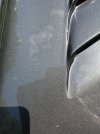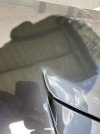I have a Cervini’s fiberglass hood. I let it cure for a week in the sun, then hit it with 220 and let it cure in the sun a few more days.
Then I took the plastic vents and washed them with Dawn and then Ajax and then back with Dawn and then SPI waterborne wax and grease remover. Sanded them with 180 and the surrounding areas and then used VPA on the area followed by Dolphin glaze.
3 coats of SPI 2k primer and let it sit in the sun 3 days. Saw the lines start to form so sanded the area, another coat of glaze and let that sit overnight. The 2 more coats of 2K primer. Let it sit a few days blocked to 600 wet with no issues.
I did not use a sealer and wonder if I should have shot a reduced epoxy sealer coat.
Base coated and let it sit 22 hours before 5 coats of Universal with 30 minutes dry time between coats.
Sat in the shop overnight with no lines but while baking in the sun I can see them.
Customer says it looks great and they’re happy with it before cut and buff but my question is will this loose adhesion in this area and cause delamination later down the road?
When cutting and buffing should I mask off that area and not touch it?
Thanks for any help. First fiberglass hood I’ve done.
Then I took the plastic vents and washed them with Dawn and then Ajax and then back with Dawn and then SPI waterborne wax and grease remover. Sanded them with 180 and the surrounding areas and then used VPA on the area followed by Dolphin glaze.
3 coats of SPI 2k primer and let it sit in the sun 3 days. Saw the lines start to form so sanded the area, another coat of glaze and let that sit overnight. The 2 more coats of 2K primer. Let it sit a few days blocked to 600 wet with no issues.
I did not use a sealer and wonder if I should have shot a reduced epoxy sealer coat.
Base coated and let it sit 22 hours before 5 coats of Universal with 30 minutes dry time between coats.
Sat in the shop overnight with no lines but while baking in the sun I can see them.
Customer says it looks great and they’re happy with it before cut and buff but my question is will this loose adhesion in this area and cause delamination later down the road?
When cutting and buffing should I mask off that area and not touch it?
Thanks for any help. First fiberglass hood I’ve done.


